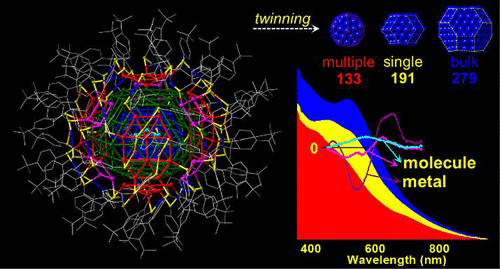当前位置:
X-MOL 学术
›
J. Am. Chem. Soc.
›
论文详情
Our official English website, www.x-mol.net, welcomes your
feedback! (Note: you will need to create a separate account there.)
The Missing Link: Au191(SPh-tBu)66 Janus Nanoparticle with Molecular and Bulk-Metal-like Properties
Journal of the American Chemical Society ( IF 14.4 ) Pub Date : 2020-09-03 , DOI: 10.1021/jacs.0c05685 Naga Arjun Sakthivel 1 , Masoud Shabaninezhad 2 , Luca Sementa 3 , Bokwon Yoon 4 , Mauro Stener 5 , Robert L Whetten 6 , Guda Ramakrishna 7 , Alessandro Fortunelli 3 , Uzi Landman 4 , Amala Dass 1
Journal of the American Chemical Society ( IF 14.4 ) Pub Date : 2020-09-03 , DOI: 10.1021/jacs.0c05685 Naga Arjun Sakthivel 1 , Masoud Shabaninezhad 2 , Luca Sementa 3 , Bokwon Yoon 4 , Mauro Stener 5 , Robert L Whetten 6 , Guda Ramakrishna 7 , Alessandro Fortunelli 3 , Uzi Landman 4 , Amala Dass 1
Affiliation

|
Understanding the evolution of the structure and properties in metals from molecule-like to bulk-like has been a long sought fundamental question in science, since Faraday's 1857 work. We report the discovery of a Janus nanomolecule, Au191(SPh-tBu)66 having both molecular and metallic characteristics, explored crystallographically and optically and modeled theoretically. Au191 has an anisotropic, singly twinned structure with an Au155 core protected by a ligand shell made of 24 monomeric [-S-Au-S-] and 6 dimeric [-S-Au-S-Au-S-] staples. The Au155 core is composed of an 89-atom inner core and 66 surface atoms, arranged as [Au3@Au23@Au63]@Au66 concentric shells of atoms. The inner core has a monotwinned/stacking-faulted face-centered-cubic (fcc) structure. Structural evolution in metal nanoparticles has been known to progress from multiply twinned, icosahedral, structures in smaller molecular sizes to untwinned bulk-like fcc monocrystalline nanostructures in larger nanoparticles. The monotwinned inner core structure of the ligand capped Au191 nanomolecule provides the critical missing link, and bridges the size-evolution gap between the molecular multiple-twinning regime and the bulk-metal-like particles with untwinned fcc structure. The Janus nature of the nanoparticle is demonstrated by its optical and electronic properties, with metal-like electron-phonon relaxation and molecule-like long-lived excited states. First-principles theoretical explorations of the electronic structure uncovered electronic stabilization through the opening of a shell-closing gap at the top of the occupied manifold of the delocalized electronic superatom spectrum of the inner core. The electronic stabilization together with the inner core geometric stability and the optimally stapled ligand-capping anchor and secure the stability of the entire nanomolecule.
中文翻译:

缺失的环节:Au191(SPh-tBu)66 Janus 纳米粒子,具有分子和块状金属样特性
自法拉第 1857 年的工作以来,了解金属的结构和性质从分子状到块状的演变一直是科学中长期寻求的基本问题。我们报告了 Janus 纳米分子 Au191(SPh-tBu)66 的发现,该分子具有分子和金属特性,在晶体学和光学上进行了探索,并进行了理论建模。Au191 具有各向异性的单孪晶结构,Au155 核由配体壳保护,配体壳由 24 个单体 [-S-Au-S-] 和 6 个二聚体 [-S-Au-S-Au-S-] 订书钉组成。Au155 核由 89 个原子的内核和 66 个表面原子组成,排列为 [Au3@Au23@Au63]@Au66 原子的同心壳。内核具有单孪晶/堆叠断层面心立方 (fcc) 结构。已知金属纳米粒子的结构演变从较小分子尺寸的多重孪晶、二十面体结构发展到较大纳米粒子中的非孪晶块状 fcc 单晶纳米结构。配体封端的 Au191 纳米分子的单孪晶内核结构提供了关键的缺失环节,并弥合了分子多重孪晶机制与具有非孪晶 fcc 结构的块状金属类颗粒之间的尺寸演化差距。纳米粒子的 Janus 性质通过其光学和电子特性得到证明,具有类似金属的电子声子弛豫和类似分子的长寿命激发态。电子结构的第一性原理理论探索通过在内核的离域电子超原子光谱的占据流形顶部打开壳闭合间隙来揭示电子稳定性。电子稳定性与内核几何稳定性和最佳钉合配体封端锚一起确保整个纳米分子的稳定性。
更新日期:2020-09-03
中文翻译:

缺失的环节:Au191(SPh-tBu)66 Janus 纳米粒子,具有分子和块状金属样特性
自法拉第 1857 年的工作以来,了解金属的结构和性质从分子状到块状的演变一直是科学中长期寻求的基本问题。我们报告了 Janus 纳米分子 Au191(SPh-tBu)66 的发现,该分子具有分子和金属特性,在晶体学和光学上进行了探索,并进行了理论建模。Au191 具有各向异性的单孪晶结构,Au155 核由配体壳保护,配体壳由 24 个单体 [-S-Au-S-] 和 6 个二聚体 [-S-Au-S-Au-S-] 订书钉组成。Au155 核由 89 个原子的内核和 66 个表面原子组成,排列为 [Au3@Au23@Au63]@Au66 原子的同心壳。内核具有单孪晶/堆叠断层面心立方 (fcc) 结构。已知金属纳米粒子的结构演变从较小分子尺寸的多重孪晶、二十面体结构发展到较大纳米粒子中的非孪晶块状 fcc 单晶纳米结构。配体封端的 Au191 纳米分子的单孪晶内核结构提供了关键的缺失环节,并弥合了分子多重孪晶机制与具有非孪晶 fcc 结构的块状金属类颗粒之间的尺寸演化差距。纳米粒子的 Janus 性质通过其光学和电子特性得到证明,具有类似金属的电子声子弛豫和类似分子的长寿命激发态。电子结构的第一性原理理论探索通过在内核的离域电子超原子光谱的占据流形顶部打开壳闭合间隙来揭示电子稳定性。电子稳定性与内核几何稳定性和最佳钉合配体封端锚一起确保整个纳米分子的稳定性。









































 京公网安备 11010802027423号
京公网安备 11010802027423号